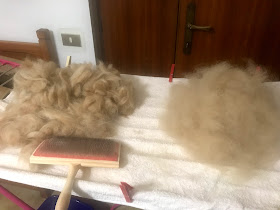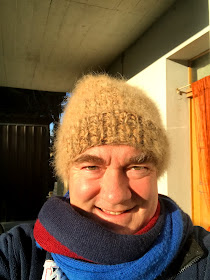La mia presentazione "Fatti di Dati, Dati di Fatti" Evoluzione dell'immateriale
Wednesday, January 30, 2019
Monday, January 28, 2019
Dog Wool Adventures
I am the lucky owner of this amazing creature named Loti (a Golden Retriever dog)
Having groomed Loti every week since when I adopted him in 2012, by the end of 2018 I had enough hair to begin the adventure of creating actual clothes with his wool.
It was a very interesting project, in which we were learning a lot and having a lot of fun.
The activities we performed may not be the best possible way to make garments out of dog's hair: Considering our previous zero experience in the field, there could be far better and more effective ways.
Anyway, this is what we did:
1. Actual hair (fleece) collection: this process in my case lasted 5 years.
2. Hand washing fleece in cold water, with shampoo and conditioner, to prevent felting
3. Rinsing and slow drying
4. Hand removal of any impurities
5. Carding: a sort of combing performed (in my case) with hand carders tools
6. Preparation of rolags, suitable for spinning
7. Hand spinning, in my case with a spinning wheel, producing threads called singles
8. Plying, which is combining more singles getting a composite yarn filament (to be arranged in skeins)
9. Knitting the yarn to produce the garments
The spinning wheel I bought is the Ashford traditional, single belt drive. I bought it from the Italian official importer TessereIncontri ( http://www.tessereincontri.org/ )
The spinning wheel comes with assembly instructions, that I was carefully following. (not more complex than any ikea furniture, but this thing is quality solid wood).
I bought also a pair of standard classic hand carders, 72 points density.
The quality of the products I bought is excellent: wood is solid, construction is accurate. After careful assembly the spinning wheel is robust and strong. I decided to buy the traditional model, which is solid ash wood, with no paint.
---------
Now some pictures about our process.
This is the wool after being washed, purfied form grass and dirt, and separated in locks.
Rolags are "wool sausages", where the fibers are prepared in a roll, so to ease spinning.
Learning to spin and actual spinning required quite an effort. It was not easy to understand how to use the spinning wheel and how to use my own fingers.
It took a while and lots of youtube search and watch.
This is how one of my first spools looked after spinning.
With wool spinning you produce a thread which is called a single. This thread has to be coupled with at least another thread to become usable yarn. Two or more singles combined become yarn thru the process of plying.
Here is one of our skeins and a ball of our 3-plyed yarn.
We decided to ply Loti's wool with two other threads: one single made from another wool (a superwashed wool we bought), and an acrylic yarn. The intention of this being to increase the yield of our wool (we did not have that much) and to reduce itchiness.
We made many of these balls, and out of those my partner knitted two beautiful caps and a large scarf. They are really super warm!
and Thank you Loti! Woof!
Having groomed Loti every week since when I adopted him in 2012, by the end of 2018 I had enough hair to begin the adventure of creating actual clothes with his wool.
It was a very interesting project, in which we were learning a lot and having a lot of fun.
The activities we performed may not be the best possible way to make garments out of dog's hair: Considering our previous zero experience in the field, there could be far better and more effective ways.
Anyway, this is what we did:
1. Actual hair (fleece) collection: this process in my case lasted 5 years.
2. Hand washing fleece in cold water, with shampoo and conditioner, to prevent felting
3. Rinsing and slow drying
4. Hand removal of any impurities
5. Carding: a sort of combing performed (in my case) with hand carders tools
6. Preparation of rolags, suitable for spinning
7. Hand spinning, in my case with a spinning wheel, producing threads called singles
8. Plying, which is combining more singles getting a composite yarn filament (to be arranged in skeins)
9. Knitting the yarn to produce the garments
The spinning wheel I bought is the Ashford traditional, single belt drive. I bought it from the Italian official importer TessereIncontri ( http://www.tessereincontri.org/ )
The spinning wheel comes with assembly instructions, that I was carefully following. (not more complex than any ikea furniture, but this thing is quality solid wood).
I bought also a pair of standard classic hand carders, 72 points density.
The quality of the products I bought is excellent: wood is solid, construction is accurate. After careful assembly the spinning wheel is robust and strong. I decided to buy the traditional model, which is solid ash wood, with no paint.
---------
Now some pictures about our process.
This is the wool after being washed, purfied form grass and dirt, and separated in locks.
It is very important to avoid any felting during the wash process. We performed it in cold water, using either: light shampoo and hair conditioner or wool specific detergent and softener.
After carding, we get fibers that are mixed, averaged and separated, either in "cloud" or in "rolag" form.
Rolags are "wool sausages", where the fibers are prepared in a roll, so to ease spinning.
Learning to spin and actual spinning required quite an effort. It was not easy to understand how to use the spinning wheel and how to use my own fingers.
It took a while and lots of youtube search and watch.
This is how one of my first spools looked after spinning.
With wool spinning you produce a thread which is called a single. This thread has to be coupled with at least another thread to become usable yarn. Two or more singles combined become yarn thru the process of plying.
Here is one of our skeins and a ball of our 3-plyed yarn.
We decided to ply Loti's wool with two other threads: one single made from another wool (a superwashed wool we bought), and an acrylic yarn. The intention of this being to increase the yield of our wool (we did not have that much) and to reduce itchiness.
We made many of these balls, and out of those my partner knitted two beautiful caps and a large scarf. They are really super warm!
and Thank you Loti! Woof!















